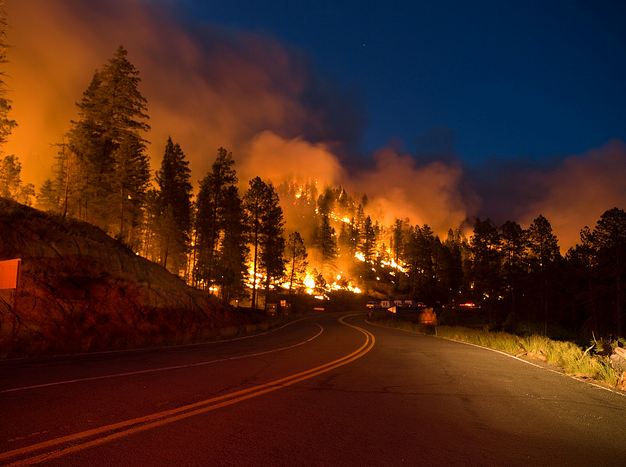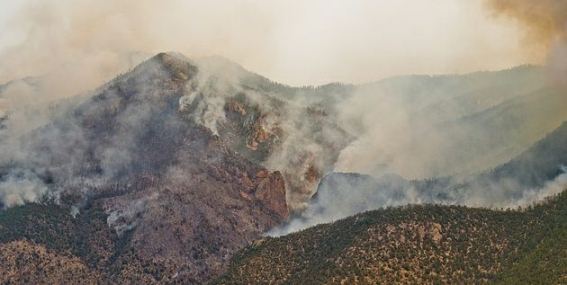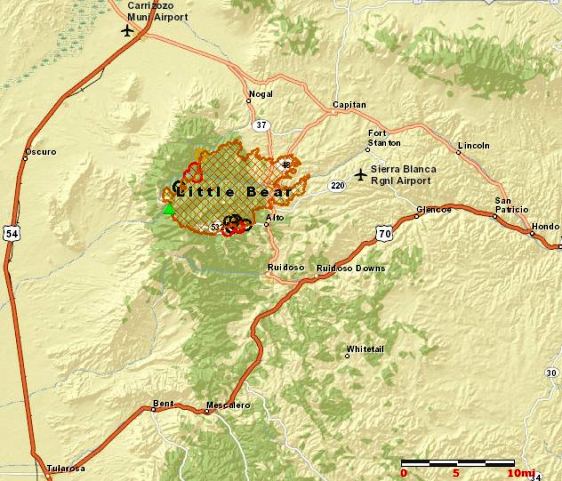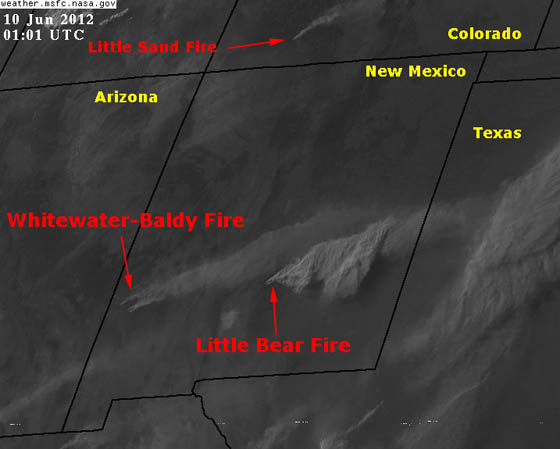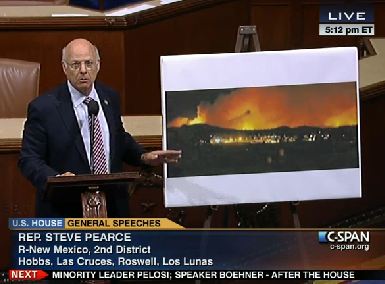 In a speech on the floor of the House of Representatives Thursday night, Representative Steve Pearce, a Republican from New Mexico, heavily criticized the U.S. Forest Service, mentioning the name of Tom Tidwell, Chief of the Forest Service, many times. During the 22-minute speech which can be viewed on C-SPAN, he displayed to television cameras and a mostly empty chamber a poster-size photograph of the Little Bear fire as it burned near the town of Ruidoso.
In a speech on the floor of the House of Representatives Thursday night, Representative Steve Pearce, a Republican from New Mexico, heavily criticized the U.S. Forest Service, mentioning the name of Tom Tidwell, Chief of the Forest Service, many times. During the 22-minute speech which can be viewed on C-SPAN, he displayed to television cameras and a mostly empty chamber a poster-size photograph of the Little Bear fire as it burned near the town of Ruidoso.
Rep. Pearce was very critical of what he described as the USFS’s policy of reintroducing fire to the forest and the abandonment of the 10 a.m. policy of attempting to suppress fires by 10 a.m. the next morning, or failing that, by 10 a.m. the next day. Pearce said he talked with Chief Tidwell about the 10 a.m. policy who told him that “it worked too well”, which did not please Rep. Pearce.
The Representative also said the USFS should do more thinning, and cited an example along with another poster of a thinned forest that was visited by last year’s Wallow fire in Arizona. He pointed out that the crown fire slowed and dropped to the forest floor when it entered the thinned area.
Some of the statements that Rep. Pearce made about long term fire effects could be questioned by wildfire experts, but he also indirectly recommended prompt aggressive initial attack on emerging fires. Surprisingly, he only mentioned air tankers once or twice, and that was in relation to them not being used, he said, on the Little Bear fire until late in the fourth day.
He did not say anything about sponsoring legislation or restoring funding for the federal land management agencies.
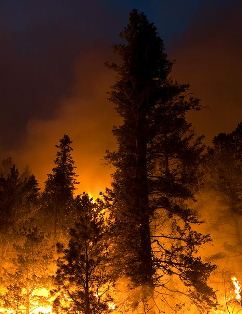
What set Rep. Pearce off appeared to be the management of the Little Bear Fire which has grown to 43,000 acres and has burned 242 residential and commercial structures. According to the Representative, the fire was 1/4 acre for a day, then grew to four acres for the next three days, during which time there were no air tanker drops until late on the fourth day.
Rep. Pearce then said: “I think that the decisions locally are made by people who are trying to follow the policy of reintroducing fire into the forest.”
The size and the time line he mentioned are fairly consistent with the details provided by the Operations Section Chief on the fire, Carl Schwope, in a video we posted June 18. However, Mr. Schwope did not address the use of aircraft during the first four days. We wrote then about the information he provided in the video:
The fire started June 4 and the Forest Supervisor authorized the use of chain saws and dozers in the wilderness area. Firefighters contained it at four acres with a line around it. After “several days” of mop up, on June 7 an interior pocket of unburned fuel flared up causing some trees to ignite and torch, sending burning embers across the line. The weather on June 8 “caused the fire to make a significant run”, then it was off to the races.
Dave Warnack, the USFS District Ranger where the Little Bear Fire is burning, has been very defensive about the reports that the fire was contained during the first four days. In an article in the Ruidoso News, Ranger Warnack blamed “miscommunication” for those reports.
We have ranted before about the confusion and misuse of the terms “contain” and “control”. Contain simply means there is a fireline around the fire which can reasonably be expected to stop the fire’s spread. There is no guarantee that the fire will never spread any further. Control means that the Incident Commander stakes their reputation on their belief that no additional acres will burn. These definitions in more formal language can be found in the National Wildfire Coordination Group’s Glossary. If someone declares a fire OUT, they are saying nothing is burning on the fire and there is no chance in hell that it will spread.
According to the Ruidoso News article, the fire which started June 4 was being managed under a full suppression strategy. There were some helicopter water drops on day four, June 7, but they were largely ineffective due to the tree canopy. The helicopters had difficulty lifting 300-gallon water blivets to the fire at the 10,200-foot elevation, so they settled for 75-gallon blivets, which were used for filling backpack pumps.
The article explains what happened next:
“By the morning of (June 8, day 5), when this thing blew up, we had completed a preliminary hand-line around (the fire),” (Ranger) Warnack said. Crews were beginning to mop-up the edges, working their way towards the center of the fire with shovels and backpack pumps, each containing five gallons of water, he said.
Then the winds increased, gusting to 40 mph, he said.
“Inside of that (hand-line) a couple of trees torched, (the fire) climbed up into the crown of those trees,” he said. “There were only a few, but with the winds, some of those embers got pushed out to the other side of the line into the grass.”
Two air tankers were ordered on the fire, but were unsuccessful in stopping the expanding blaze, which was starting spot fires far ahead of containment efforts, the report stated.
An armchair Incident Commander with the benefit of 20/20 hindsight might wonder why there were not enough ground and air resources on hand to not just complete a fireline around the four-acre fire and “begin mopup” on day five, but to do 100 percent mopup during the first four days. And assuming that the IC had an accurate weather forecast predicting the wind event on day five, that forecast could have provided even more incentive and plenty of justification to bring in a helicopter to wash the four-acre fire off the hill, and enough ground resources to turn over every square inch of the four-acre fire during those first four days. On most 4-acre fires in a remote location that are moving very slowly or not spreading, this can usually be done by one helicopter and a hand crew over one to three days. Of course all of this is easy to say from an armchair.

